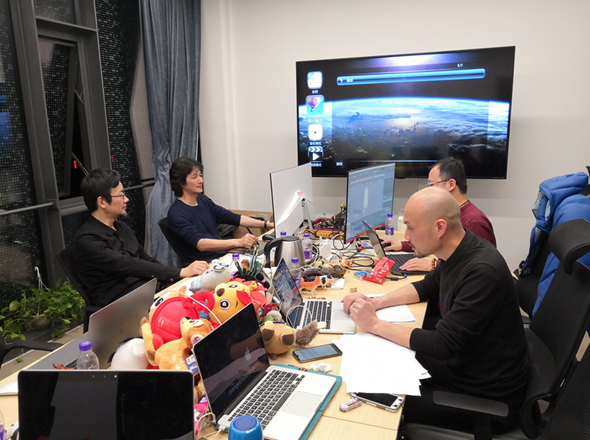Bing Dwen Dwen: A success of collective wisdom and inspiration
 0 Comment(s)
0 Comment(s) Print
Print E-mail China.org.cn, February 10, 2022
E-mail China.org.cn, February 10, 2022

"I didn't expect Bing Dwen Dwen (the mascot of the Beijing 2022 Olympic Winter Games) to become so popular. Many friends have asked me whether I can help them get one. Some invited me to sign my name on the mascots they bought," Liu Pingyun, chief executive of the design team of Bing Dwen Dwen and deputy dean of the School of Visual Arts and Design at the Guangzhou Academy of Fine Arts, told China.org.cn during an exclusive interview on Feb. 6.
As an important element of the overall visuals of the Beijing Winter Olympics, the mascot has been highly regarded and loved by many since its conception in 2019. It combines the image of a giant panda with an ice crystal shell, combining elements of winter sports and flashes of modern technology.
As the Games, which opened on Feb. 4, are watched by millions at home and abroad, souvenirs of the mascot have been sold out overnight in China in both brick-and-mortar outlets and online stores.
Liu giggled: "We do not have stock either. We would have bought more if we knew it was going to be this popular!"
Since being unveiled on Sept. 17, 2019, Bing Dwen Dwen has become a highly recognizable symbol of the Games. International Olympic Committee President Thomas Bach spoke highly of its design, saying that Bing Dwen Dwen combines elements of traditional Chinese culture and a modern international style.
Liu believed that the reason why Bing Dwen Dwen's image resonates around the world is that it has three features.
That includes the ice crystal shell — based on the icing of bingtanghulu (crispy sugar-coated haw), which symbolizes sweetness, Liu said.
The inspiration for this design came from one of Liu's childhood memories: "I am a native of Xinyu, Jiangxi province (in southeastern part of China). When I was a child, my imagination of north China was icy skies and bingtanghulu."
The team kept the ice shell of bingtanghulu, but replaced the character under the ice shell with a panda, which has much higher recognition abroad.
Meanwhile, a colorful ice ribbon breaks the simple black and white of the panda visually. Finally, the heart pattern in the left-hand palm represents peace and hope and the warm welcome from the host country to friends around the world, Liu noted.
Mascot gifts for medalists at the Games are customized. They are adorned by a wreath woven of pine, bamboo and plum — known as the "Three Friends of the Cold."
Liu said: "The organizing committee of the Games decided to combine the elements of pine, bamboo and plum in a single wreath, symbolizing the athletes' tenacity, perseverance, and vigorous vitality."
Panda has now been mascots for big sports events in China on three occasions, including the Asian Games in 1990 and the Beijing Olympics in 2008.
According to Liu, Bing Dwen Dwen is different from previous panda mascots in that it combines traditional cultural heritage with new technological breakthroughs and innovations in the new era.
The design of Bing Dwen Dwen is innovative in three aspects, Liu said.

The designers abandoned traditional methods such as hand and ink painting, and instead used three-dimensional technology to create it, presenting a new visual experience.
They then display the National Speed Skating Oval, dubbed the "Ice Ribbon" on the helmet of Bing Dwen Dwen, with the bright-colored halo around its face representing ice and snow sport tracks.
In addition, the image of Bing Dwen Dwen looks like an astronaut, given that space exploration is the common pursuit of mankind.
"Space has no national boundaries, and the Olympics transcend national boundaries," Liu said. "In a sense, China's active engagement in space exploration is also promoting the building of a community with a shared future for mankind."
Liu's team also had a hand in designing the mascots of the Asian Games held in Guangzhou in 2010 as well as several other big events hosted by the city.
The Bing Dwen Dwen design team, led by Professor Cao Xue, consists of 14 teachers and students from the Guangzhou Academy of Fine Arts. "Bing Dwen Dwen is a result of countless revisions and is the crystallization of our collective wisdom. Our teamwork embodies the Olympic motto of 'Higher, Faster, Stronger — Together,'" Liu said.
Liu added that as the Games is a world-class event, every member of the team attached great significance to the work. The image of Bing Dwen Dwen is a result of 21 rounds of large-scale revisions and countless small adjustments over a period of about 10 months.
Looking back at the work, Liu said the moment when they wanted to give it up was exactly the moment they were closest to success.






Go to Forum >>0 Comment(s)